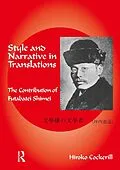Futabatei Shimei (1864-1909) is widely regarded as the founder of the modern Japanese novel. His novel Floating Clouds (1887-1889) was written in a colloquial narrative style that was unprecedented in Japanese literature, as was its negative hero. Futabatei was also a pioneer translator of Russian literature, translating works by Turgenev, Gogol, Tolstoy, Gorky and others - his translations had an enormous impact (perhaps even greater than his novels) on the development of Japanese literature.
In this groundbreaking work, Hiroko Cockerill analyses the development of Futabatei's translation style and the influence of his work as a translator on his own writing. She takes us on a journey through Russian and Japanese literature, throwing light on the development of Japanese literary language, particularly in its use of verb forms to convey notions of tense and aspect that were embedded in European languages.
Cockerill finds that Futabatei developed not one, but two distinctive styles, based on the influences of Turgenev and Gogol. While the influence of his translations from Turgenev was immediate and far-reaching, his more Gogolian translations are fascinating in their own right, and contemporary translators would do well to revisit them.
Autorentext
Hiroko Cockerill began her career as a teacher of Japanese language and literature in Japan. She then spent five years studying Russian language and literature in Tokyo and Moscow, before immigrating to Australia, where she has lived for the past 17 years. She is currently a research adviser and teacher at the University of Queensland in Brisbane, Australia.
Inhalt
Introduction
System for Indicating Tense and Aspect of Verbs
Chapter 1: The Significance of The Tryst in Japanese Translation History
Chapter 2: The Development of Futabatei's Translation Style
Recognition of Aspect in the Japanese Language
Futabatei's Use of "-ta" Form Verbs
Futabatei's Translation of Past Imperfective and Past Perfective Verbs
Chapter 3: Exploring the First-Person Narrative
Katakoi [One-sided Love]
Yudaya-jin [The Jew]
Chapter 4: A Third-person Narrative: The Portrait
Chapter 5: Third-Person Narratives: Floating Weed and The Mismatch: The Restoration of "-ta" Expressing the Past Tense
Ukikusa [Floating Weed]
Kusare-en [The Mismatch]
Chapter 6: Futabatei's Translation Style and the Styles of Koyo and Ryuro
Chapter 7: Futabatei's Third Period of Translation Activity and In His Image
Tsutsu o makura [A Rifle for a Pillow]
Yokka-kan [Four Days]
Fusagi no mushi [The Depression Bug]
Mukashi no hito [Olden Day People]
Sono omokage [In His Image] (Futabatei's second original work)
Chapter 8: 1907: Futabatei's Final Year of Literary Activity
Ni kyojin [Two Madmen]
Kyojin nikki [A Madman's Diary]
Futabatei's Final Original Work Heibon [Mediocrity]
Natsume Soseki's Kofu [The Miner] and Shimazaki Toson's Haru [Spring]
Conclusion: Re-evaluating Futabatei's Translations and their Significance for Contemporary Literature
Appendix : A List of Futabatei Shimei's Translations and Original Works
